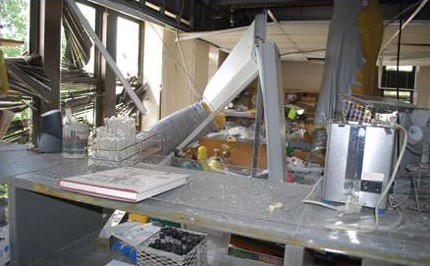Last Revised: April 16, 2018
The requirements in Penn's Chemical Hygiene Plan SOP: Hazardous and Highly Toxic Gases apply to all work involving hydrogen gas. The Fact Sheet below gives hazard information and precautions for use of hydrogen in anaerobic chambers; however, this information is provided as a supplement to the SOP, which must first be read and understood by anyone planning to work with hydrogen gas in this manner.
Contact EHRS to review your plans before any new installations of anaerobic chambers using hydrogen gas.
Description
Anaerobic chambers are used to provide an oxygen free atmosphere for work with oxygen sensitive materials. A hydrogen (H2) gas mixture is circulated through a heated palladium catalyst to remove oxygen (O2) by forming water (H2O). Anaerobic chambers use a mix of H2 and nitrogen (N2) (5/95%) or N2/carbon dioxide (CO2)/H2 (85/10/5 %) to remove oxygen. An airlock is used to reduce O2 levels prior to the transfer of samples in and out of the chamber.
Hydrogen
At standard temperature and pressure, hydrogen is a colorless, tasteless, odorless gas. Hydrogen gas is highly flammable and will burn in air in concentrations between 4% and 75% by volume. Hydrogen is not toxic, but in its pure form is a chemical asphyxiant. Hydrogen gas leaking into air may spontaneously ignite. Hydrogen fire burns with an almost invisible flame.
Hazards
Hydrogen has a wide flammability range in comparison to other gases. A low concentration of hydrogen gas in combination with an ignition source (such as an anaerobic chamber heated catalyst) is enough to cause a fire or explosion. Laboratory accidents have occurred when very high levels of hydrogen were accidentally introduced into the anaerobic chamber during purge cycles, when air leaked into the anaerobic chamber during maintenance or experimentation, or when an incorrect mix of gases was used to purge the chamber.

Procedures for Safely Operating Anaerobic Chambers
To reduce the risk of fire or explosion:
- Purge chambers, airlocks and antechambers with 100% nitrogen (or another inert gas).
- Do not use mixtures containing >5% hydrogen. Use a 5% hydrogen gas mixture (95% N2/5% H2) with a palladium catalyst to eliminate oxygen from the chamber and keep flammability low. An auxiliary desiccant/palladium dryer may be required to maintain anaerobic conditions for some chambers.
- Verify that the correct hydrogen mixture was shipped by the vendor before connecting new cylinders.
- Use an oxygen/hydrogen gas analyzer to monitor gas levels in the chamber. The monitor will detect a problem with the gas mixture, valves or regulators.
- Leak test gas lines and the anaerobic chamber before start up.
- Provide employee training that reviews leak testing, purging procedures and emergency procedures. Document employee training.